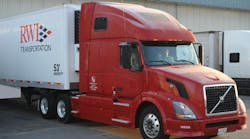Manager: Kenny Carpenter
Title: Fleet maintenance manager
Fleet: RWI Transportation, Wilder, KY
Operation: Produce carrier with 280 company-owned refrigerated trailers pulled by 250 owner-operator power units
Problem:
Tires for both trucks and trailers remain one of the top three cost centers for any fleet, be it an over-the-road carrier or vocational operation. Yet controlling tire costs can be a ticklish business, as Kenny Carpenter can tell you. So many variables—from tire design to operating conditions—affect tread depth and wear patterns and ultimately impact the expected longevity of a tire. Thus, the key to finding the right tires for the right operation boils down to getting data—and lots of it.
Carpenter joined RWI Transportation two years ago after a nearly 20-year career spent in trucking’s maintenance trenches. He started out in the 1990s with Baylor Trucking as a trailer mechanic, then worked his way up to diesel technician. Along the way, there was a stop as shop foreman at a local Freightliner dealer before joining RWI as fleet maintenance manager.
Originally, RWI employed its own in-house tire tracking system that, while somewhat effective, did not track several key metrics, he said.
“[We knew] what tires were put on our trailers and what happened to those tires, but we didn’t have a way to track any of that,” Carpenter notes. “We wanted to have all of that information at our fingertips.”
Solution:
Carpenter settled on the Tire Trac online management program offered by Goodyear Tire & Rubber through its Goodyear-FleetHQ division.
The system provides real-time information and helps RWI track long-term tire trends. Tire Trac data is gathered through fleet surveys conducted by technicians at Goodyear commercial tire dealerships or Goodyear Commercial Tire & Service Centers. They perform on-site tire inspections, measuring tire inflation levels, tread depth and other aspects of a tire’s condition. That captured information is then used to create customized reports that show how a fleet’s tires are performing.
Carpenter felt the Tire Trac system would be ideal for RWI because the carrier doesn’t have its own network of maintenance shops. This made it difficult for him to keep tabs on the company’s trailers themselves, much less its tires. With access to Tire Trac data, he avoids costly road service calls due to tire failures because he can now make proactive decisions on when to replace tires.
“A trailer will leave out of here and go out to one of our terminals in Dallas or Bloomington, CA, and I won’t see it for six months,” he explains. “In that time period, maybe two or even three tires might get replaced depending on what’s happened on the road. In the past, I wouldn’t know the reason why it got replaced or even the type or brand of replacement tire.”
Now, Gem City Tire, a local Goodyear commercial tire dealership, sends a technician to RWI’s Wilder hub twice a week to check inflation pressure, tread depth and other things. From there, Gem City—or RWI itself—can download information and create customized reports. On top of that, tire technicians from Goodyear locations near RWI’s terminal across the country perform similar functions. “They visit us at least once a week, sometimes more often,” said Carpenter.
The upshot of the program, he said, is that RWI has saved some $40,000 in tire-related expenses over the last 18 months in addition to realizing a $15,000 reduction in road service costs over that time period.
“Right off the bat, we cut down our road calls by about maybe one-quarter or one-third simply because we were getting better information about the condition of our trailer tires and making those frequent fleet checks at our locations,” Carpenter explains. “We also got a better look at how certain tire types held up over time. For example, we found one type provided us with 15,000 more miles per 32nd of tread depth—and that, of course, influenced what types of trailer tires we use.”



